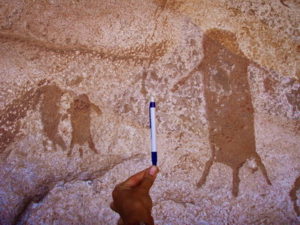Although this catalogue is dedicated exclusively to the Round Head paintings and petroglyphs, we also include the Kel Essuf petroglyphs. Why? The Kel Essuf are stylized anthropomorphic figures completely different from Saharan petroglyphs of other styles. They consist of an oval body with short arms and legs, sometimes with fingers. In most cases they have a fifth appendage between the legs suggesting a penis.

Kel Essuf peckings, Algerian Tadrart
In 1967 an Italian archaeologist Fabrizio Mori postulated that the Kel Essuf are an original form from which Round Head paintings evolved, and this hypothesis seems to be confirmed by subsequent studies (Hallier & Hallier 1999, Striedter et al.2002-03).
The Kel Essuf petroglyphs are not only very similar to the presumed early forms of the Round Head figures, but they are also located in the same region, namely in the Algerian Tadrart, the Acacus and the Djado, where they often coexist with the Round Head paintings in the same shelters and on the same rock walls. In addition: Round Head -peckings comprise a rich horizon of symbolic, enigmatic peckings or signs which are supposed to be the forerunners of the pictures of human beings.This “symbolic” horizon is shown in the catalogue.
Especially in the Djado mountains Ulrich and Brigitte Hallier believe to have found numerous painted, but also pecked Round Head figures. This fact is supported by some Kel Essuf figures in the Algerian Tadrart which appear both pecked and painted.
Similar body shapes, attributes and locations of both Kel Essuf and Round Heads are likely to indicate at least the same cultural matrix of their creators.
See the PETROGLYPHS